If It Flies It Dies – WARSAW PACT AIR DEFENSE OPTIONS IN TEAM YANKEE
By Jim Naughton
Introduction
A frequently asked question on Team Yankee (TY) forums is what ADA systems are best. This article tries to answer that question for the Warsaw Pact.
The release of World War III: Warsaw PACT https://www.flamesofwar.com/hobby.aspx?art_id=7455 added the M53/59 Praga anti-aircraft vehicle to the Czech army and corrected the omission of SA-8 Gecko from Volksarmee.
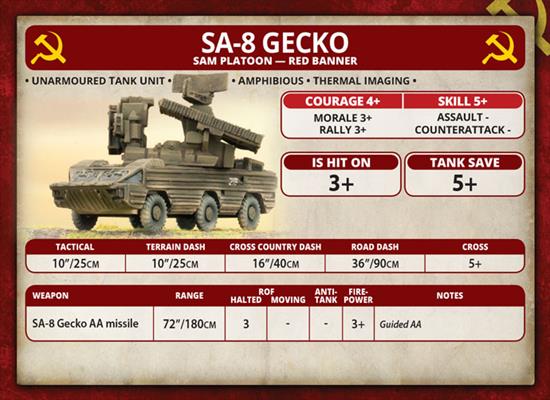
World War III: Soviet also added the Gecko to the Soviet array. And introduced the 2S6 Tunguska which briefly showed promise as a multifunctional vehicle.
Between these additions, the typical1985 division-level ADA systems of the Warsaw Pact are covered. Older Air Defense Automatic Artillery (AAA) systems continued to soldier on, particularly in PACT allies. They were necessary because cash-strapped PACT allies never reached full requirements in AAAV or SAM.
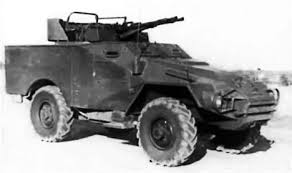
But like the absence of Gecko from the original Volksarmee publication, we can hope for a model in the future. Or simply extend Praga to other PACT allies as has been done with Cuba.
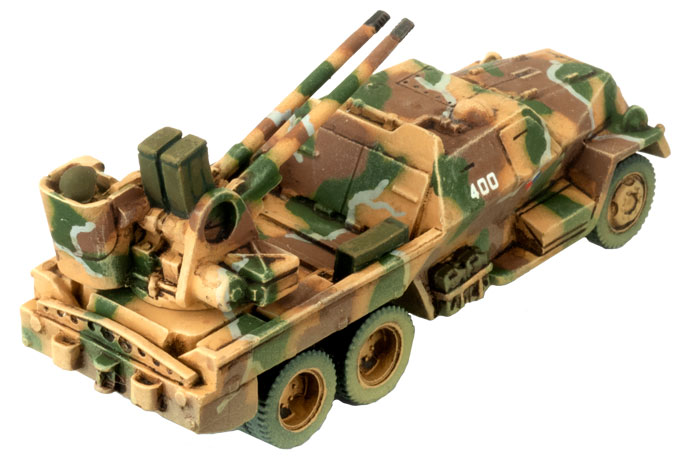
With clarification of force diagram issues for the PACT allies, full symmetry exists – allowing the PACT player to blend allied formations and black box support to suit. There are fewer reasons for blending in the ADA arena because most vehicles are now available to all plus ADA performance is unrelated to morale and/or skill.
I will briefly chronicle the PACT ADA inventory and then examine the relative effectiveness of the vehicles. Unfortunately, that will require a little MATH.
WARSAW PACT ADA ORGANIZATIONS
The Warsaw PACT ADA organizations placed antiaircraft assets at battalion, regiment, division, army, and front levels. Each infantry battalion had nine man-pack SAMs (SA-7/14/16) in an air defense platoon.
The regiment had an air defense battery, typically consisting of an air defense missile platoon and an air defense artillery platoon. Ideally, the vehicles in the regimental air defense battery’s mobility matched the regiment. I.e. tracked SAM vehicles were found in tank and BMP regiments and wheeled SAM vehicles in BTR regiments. But the ubiquitous SA-9 Gaskin substituted for SA-13 Gophers in many units.
The standard platoon was four vehicles. However, during the late ‘80s the Soviets revised the regimental battery into a battalion as more 2S6 Tunguskas became available. These new battalions had 6 Tunguskas (operating in pairs) and replaced the dedicated SAM-vehicles with 6 BMP-2s (also operating in pairs) carrying SA-14/16 teams.
The Divisional ADA Regiment was normally all SAMs. The regiment had five firing batteries of four Transporter Erector Launchers (TEL) with a radar vehicle, or four Transporter Erector Launchers and Radar (TELAR, integral radars on the vehicles). This niche was initially filled by the SA-6 Gainful. It was supplemented by the SA-8 Gecko. In the ‘80s the Soviets introduced the SA-11 Gadfly in small numbers. In TY’s period the Divisional ADA regiments could be mixed.
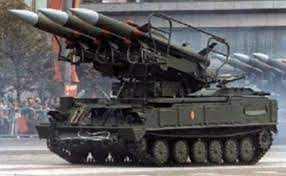
Divisional ADA regiments in Reserve Divisions were sometimes 57mm towed weapons. I don’t expect to see them in TY.
A minor rub is that every SAM section was protected by three SA-7/14/16 teams. Like the NATO Redeye/Stinger augmentations, Gecko (at least) should be augmented with an infantry attachment of Gremlins. Someday…
The Army and the Front both had at least one SAM Brigade, and the most common weapon was SA-4 Ganef. Because this is a relatively long-range system, and difficult to displace, it probably is inappropriate for Team Yankee, like NATO’s HAWK and PATRIOT systems. Each brigade fielded 27 TELs in units of three with appropriate radar and fire control vehicles.
Let’s look at the details of the systems found in Team Yankee.
AAAV (Automatic Air Defense Artillery Vehicles)
AAAV mount high-velocity automatic cannon. PACT forces operate three; the older ZSU-57 is operated by Syrian allies. Red Dawn introduces the new BTR-ZD.
M53/59 Praga
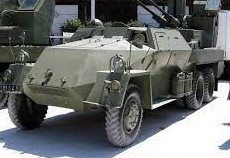
The M53/59 Praga used paired 30mm autocannon on a Praga V3S truck chassis. The weapons came from the Skoda works. The Czech Army nicknamed it Jesterka (Lizard). Fielded in the late 1950s, the crew acquired the target visually severely limiting jet engagements. Like many contemporary AAA systems, it was designed so that the guns could be dismounted and dug in. The Czech Army ran a side-by-side comparison and rejected ZSU-57.
The Czechs retained this system for all regimental AAAV, choosing not to acquire ZSU-23, although BF allows the Czechs to have ZSU-23.
In Team Yankee, the Praga is afflicted with manual tracking which gives it a +1 To-Hit vs Strike Aircraft, and lacks IR making night engagements chancy. But it can put a lot of shells down range – two vehicles outperforming a single Shilka.
ZSU-57 Sparka
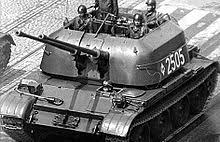
I include the ZSU-57 in this list because it can appear in an allied Syrian or Cuban formation on the tabletop. The Soviets introduced it in the ‘50’s to supplement BTR-152 and BTR-40 mounting HMGs. Testing and training exercises soon showed the 57mm S68A cannons lacked sufficient ROF, rapid traverse, and stowed load to engage jets, leading to its early demise.
The system is built on a modified T54 chassis and mounts the cannon in a large, boxy turret. The large turret allows rapid reloading but slows traverse speed. The S68A cannon is fed by four-round clips, making its practical rate of fire less than 150 rounds per minute. However, it made up for ROF in lethality per round.
In TY, the system has the same limitations as the Praga: manual tracking and no IR vision. The ZSU-57 delivers half the ROF as the Shilka, costs half as much, and has higher firepower.
The Soviets had withdrawn the ammo along with the systems as more Shilkas became available, leaving the East Germans and Poles little choice but to put their systems in storage. The companion towed 57mm system remained viable for years thanks to having an integral radar in the battery. The system remained in service in the Middle East and with Cuba.
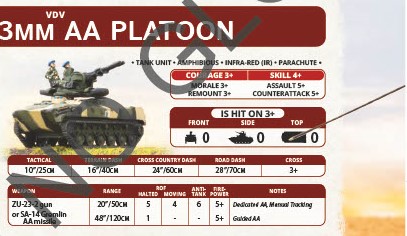
The BTR-ZD is used by Soviet Air Assault units. The BTR is a modified BMD hull intended to carry extra paratroopers and cargo in the Air Assault Divisions and the Air Assault Brigades. Designed to tow the ZU-23 autocannon or heavy mortars, in the early ’80s the Soviets decided to mount the ZU-23 on the flat external cargo platform atop the vehicle’s hull. BF gives this vehicle the choice of firing a single Gremlin instead of the ZU-23 cannon.
ZSU-23 Shilka
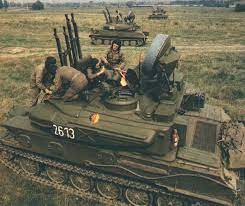
The Soviets ran several projects to improve the ZSU-57. The winning design was the ZSU-23. The system mounted an RPK-2 radar and four 23mm cannons in a single turret. The weapon was adjudged an instant success after fielding in 1965 and by 1970 had replaced half the existing ZSU-57s.
\Mounted on a modified GM575 tracked chassis it proved mechanically reliable. Operated in conjunction with SA-6 missile systems and SA-7 MANPADs it proved devastating to Israeli strike aircraft in the Yom Kippur War. That success sealed the fate of the ZSU-57 in Europe, as the ZSU-23 rapidly replaced the older system. By 1980 Soviets withdrew the ZSU-57 to storage, or sold it to various nations.
In TY, the system is rated as ‘RADAR’. This gives it a 12” range bump versus air targets and neutralizes the +1 TO-HIT at long range versus aircraft. But it still lacks IR. Eliminating the ‘manual tracking’ penalty more than offsets its reduced firepower.
2S6 Tunguska
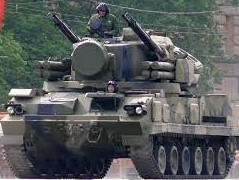
The 2S6/2K22 Tunguska system was the first Soviet hybrid gun-missile system. Its genesis was two-fold – to counter the heavily armored A-10 Thunderbolt and to offset limitations in the ZSU-23, namely lack of early warning and night vision. The 1RL Radar gives 18 kilometers of detection and 16 kilometers of tracking. The computerized fire control allows gun engagement in ten seconds.
Including missiles on the platform led to delayed fielding despite relatively smooth development. The system was perceived to be a competitor for the SA-8 Gecko mission thanks to including the powerful SA-19 Grendel missiles. Development was slowed from 1975-1977 while the issue was studied. This delayed fielding to 1984, and only to high-priority units like the First and Second Unified Corps (T80s) at first. Initially, it was a one-for-one replacement of the ZSU-23, but in the late ‘80s the organization of the regimental air defense battery changed as already noted.
Early 2S6 had only four missiles, but by 1986 the 2S6M changed to eight missiles. This is model Battlefront chose to depict in its kit.
The 2S6 is rated ‘RADAR’ just like ZSU-23. The SA-19 Grendel missile is ‘Guided AA,’ like the other missiles.
This powerful system was no sooner introduced in TY than a FM101 ruling changed how multiple-armed weapons work versus aircraft, profoundly affecting is desirability.
SAM (Surface to Air Missiles)
The other category is SAM. This includes Man-Portable Air Defense weapons (MANPADs) like the SA-7 and SA-14 as well as vehicles. These all are rated ‘Guided AA.’
SA-7 Grail and SA-14 Gremlin
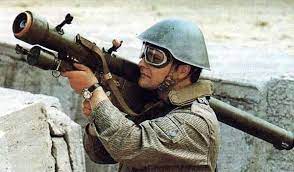
The PACT and their Arab allies get these systems on a large infantry base with ROF = 3. They are purchased as an option for an infantry company and come with a vehicle (except in the Soviet Air Assault Company). The primary difference between SA-7 and SA-14 is the improved SA-14 seeker allows head-on engagements and increased countermeasure resistance. The game doesn’t distinguish between these missiles, other than by name. The SA-16 Gimlet which arguably should have a longer range and appear in high-priority units isn’t in the game yet.
They differ from the vehicles by being able to dig in or occupy buildings. Also, they are subject to being pinned by enemy fire on the other stands of their company. So they are more likely to fire in their own turn.
SA-8 Gecko
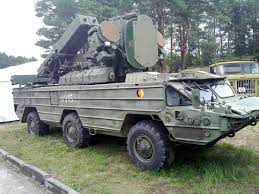
The SA-8 Gecko was developed to replace the SA-6 in the Division Air Defense Missile Regiment. Only 1,200 were built against a 4,000 system Soviet requirement, and many were sold. Soviets never built enough of the SA-8s so SA-6 remained in operation right through the end of the Cold War. The original range was 12 kilometers but by 1980 improvements allowed 15-kilometer engagements.
SA-8 was the first missile system to integrate all its radars and missiles on a single vehicle. The vehicle is a 6-wheeled boat allowing it to swim with minimal preparation. The SA-8 has the longest range and largest warhead of the Soviet Divisional ADA systems in the game (however the SA-6 warhead is almost 3 times as powerful as the SA-8).
The Battlefront model represents the 6-missile variant (SA-8B Mod 0) produced in 1975.
SA-9 Gaskin
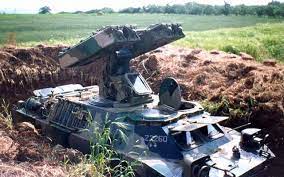
Initially designed in parallel to the SA-7 and expected to carry the same missile, the SA-9 branched off from that development stream into a unique niche. The SA-9’s 9M31 missile uses photocontrast IR tracking to allow head-on engagements, thus supplementing the SA-7 which could only engage from tail aspect. And it provided longer range than its running mate the ZSU-23, creating a ‘perfect’ storm of layered ADA defenses for the Soviet regiment.
The SA-9 is built on the BRDM-2 hull and is amphibious.
The 9M31 SA-9 missile was almost twice as large and twice as powerful as the SA-7, with the same engagement range. Battlefront accurately depicts the range but gives it SA-7’s firepower.
SA-13 Gopher
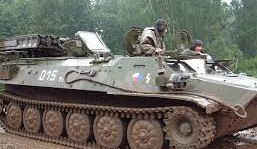
The SA-13 was designed as a ‘low-cost’ alternative to the 2S6 in the early ‘70s. It replaced the SA-9 in tracked regiments to provide comparable mobility. The proven MT-LB chassis is the basis of the vehicle. Production started in 1976.
The system uses the 9M37 missile but was designed to be backward compatible to the 9M31 of the SA-9. Its slightly larger warhead and range is reflected in TY.
Summary
This table reflects the relevant statistics for the systems above:

‘AP’ column is armor penetration, relevant for ground engagements. ‘Cost’ column shows Army Points and has 2 numbers where the Czechs have different costs. AP Cost for the SA-7/SA-14 is for just the team, established by the Soviet Air Assault Company. Riding in BMP-2 and BMP-3 it has a higher cost reflective of the vehicle. ‘ROF’ column is stationary firing followed by moving numbers. The ‘-‘ reflects that missiles can’t move and shoot in TY.
In PART II we will get into the MATH that will drive your choices.
